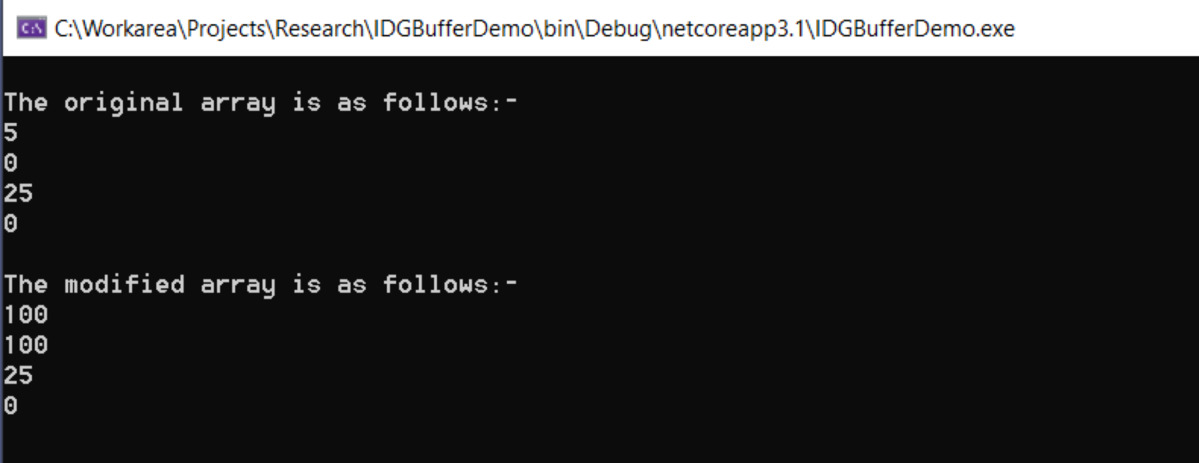缓冲区 是内存中的一组字节序列,缓冲 是用来处理落在内存中的数据,.NET 缓冲 指的是处理 非托管内存 中的数据,用 byte[] 来表示。
当你想把数据写入到内存或者你想处理非托管内存中的数据,可以使用 .NET 提供的 System.Buffer类,这篇文章就来讨论如何使用 Buffer。
Buffer 下的方法列表
Buffer 类包含了下面几个方法:
- BlockCopy(Array, Int32, Array, Int32)
用于将指定位置开始的 原数组 copy 到 指定位置开始的 目标数组。
- ByteLength(Array)
表示数组中 byte 字节的总数。
- GetByte(Array, Int32)
在数组一个指定位置中提取出一个 byte。
- SetByte(Array, Int32, Byte)
在数组的一个指定位置中设置一个 byte。
- MemoryCopy(Void, Void, Int64, Int64)
从第一个源地址上copy 若干个byte 到 目标地址中。
理解 Array 和 Buffer
在了解 Buffer 之前,我们先看看 Array 类,Array 类中有一个 Copy() 方法用于将数组的内容 copy 到另一个数组中,在 Buffer 中也提供了一个类似的 BlockCopy() 方法和 Array.Copy() 做的一样的事情,不过 Buffer.BlockCopy() 要比 Array.Copy() 的性能高得多,原因在于前者是按照 byte 拷贝,后者是 content 拷贝。
数组之间的 bytes copy
你可以利用 Buffer.BlockCopy() 方法 将源数组的字节 copy 到目标数组,如下代码所示:
static void Main()
{
short [] arr1 = new short[] { 1, 2, 3, 4, 5};
short [] arr2 = new short[10];
int sourceOffset = 0;
int destinationOffset = 0;
int count = 2 * sizeof(short);
Buffer.BlockCopy(arr1, sourceOffset, arr2, destinationOffset, count);
for (int i = 0; i < arr2.Length; i++)
{
Console.WriteLine(arr2[i]);
}
Console.ReadKey();
}

如果没看懂上面输出,我稍微解释下吧,请看这句: int count = 2 * sizeof(short) 表示从 arr1 中 copy 4个字节到 arr2 中,而 4 byte = 2 short,也就是将 arr1 中的 {1,2} copy 到 arr2 中,对吧。
理解数组中字节总长度
要想获取数组中的字节总长度,可以利用 Buffer 中的 ByteLength 方法,如下代码所示:
static void Main()
{
short [] arr1 = new short[] { 1, 2, 3, 4, 5};
short [] arr2 = new short[10];
Console.WriteLine("The length of the arr1 is: {0}",
Buffer.ByteLength(arr1));
Console.WriteLine("The length of the arr2 is: {0}",
Buffer.ByteLength(arr2));
Console.ReadKey();
}

从图中可以看出,一个 short 表示 2 个 byte, 5个 short 就是 10 个 byte,对吧,结果就是 short [].length * 2,所以 Console 中的 10 和 20 就不难理解了,接下来看下 Buffer 的 SetByte 和 GetByte 方法,他们可用于单独设置和提取数组中某一个位置的 byte,下面的代码展示了如何使用 SetByte 和 GetByte。
static void Main()
{
short[] arr1 = { 5, 25 };
int length = Buffer.ByteLength(arr1);
Console.WriteLine("\nThe original array is as follows:-");
for (int i = 0; i < length; i++)
{
byte b = Buffer.GetByte(arr1, i);
Console.WriteLine(b);
}
Buffer.SetByte(arr1, 0, 100);
Buffer.SetByte(arr1, 1, 100);
Console.WriteLine("\nThe modified array is as follows:-");
for (int i = 0; i < Buffer.ByteLength(arr1); i++)
{
byte b = Buffer.GetByte(arr1, i);
Console.WriteLine(b);
}
Console.ReadKey();
}

Buffer 在处理 含有基元类型的一个内存块上 具有超高的处理性能,当你需要处理内存中的数据 或者 希望快速的访问内存中的数据,这时候 Buffer 将是一个非常好的选择。
译文链接:https://www.infoworld.com/article/3587751/how-to-use-the-buffer-class-in-c.html
更多高质量干货:参见我的 GitHub: csharptranslate